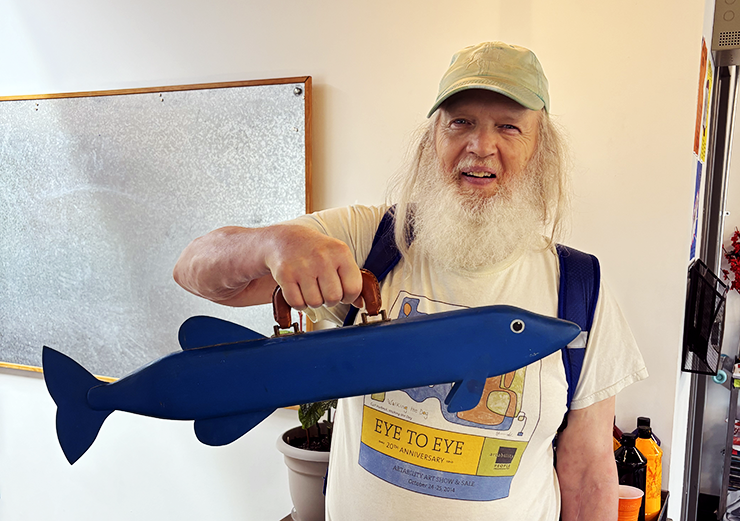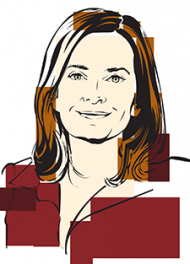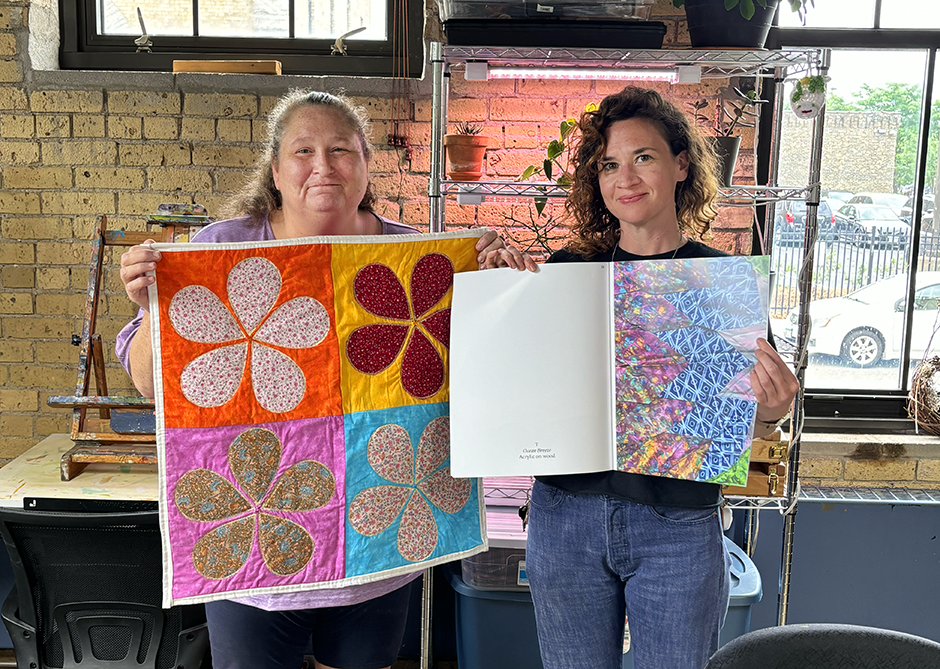For several years, staff at Avivo ArtWorks, an art-focused community support program for people with severe and persistent mental illness (SPMI), hired teaching artists to run workshops where program participants, also known as members, could learn new artistic techniques.
The approach was popular. But last year, Tovah Rudawski, Avivo ArtWorks program manager, noticed that program members themselves had so much artistic talent that she decided to flip the concept on its head. She applied for and was awarded a $20,000 grant from the Minnesota State Arts Board to fund the Teaching Artists Initiative, a multi-month series of workshops, where ArtWorks participants, people with SPMIs like schizophrenia and schizoaffective disorder, were paid to lead art classes for their peers — topics ranged from graffiti lettering to hypertufa planter-making to jewelry making.
“In my time here I’ve realized that there were many skills and artistic knowledge within the members themselves,” Rudawski said. “I really wanted to hone in on that and honor it by applying for that same pool of money but with the intent of having members lead the workshops.” Members were excited about the program, she said, adding, “We had 16 sign up to teach a variety of workshops, all arts-focused.”
The grant money mostly went to paying members to lead the classes, Rudawski explained. “Everybody was paid around $88 an hour — a really great hourly amount for the labor of being a teaching artist,” she said. The rest of the money went to purchasing workshop supplies and equipment, with a little set aside to fund a final artists’ celebration at the ArtWorks open, sunny studio space in the old Grain Belt Bottling Plant during Art-A-Whirl in Northeast Minneapolis.
One of two community support programs run by Avivo, a nonprofit social service agency focused on increasing well-being through recovery and career advancement while working to end homelessness, ArtWorks provides a safe space for members to build community connections and social support while working on their art.
Related | U of M students’ organization aims to broaden education around substance abuse
Rudawski explained that the ArtWorks program is open to residents of Hennepin County who are age 18 or older and have a SPMI diagnosis. While all members live with a mental illness, she added that it also “helps to be artistically minded or want to be a part of our program because it is really arts-focused.”
Creating art can be a way for people with SPMI to process the challenges their mental illnesses create in their lives. It can also be an effective means of communication, of explaining the way an individual experiences the world. ArtWorks members take their art seriously, Rudawski said, and the Teaching Artists Initiative grant helped to acknowledge the significance of their efforts.
“Our members look for opportunities to grow professionally,” she said. “Teaching a workshop is a great way to grow as an artist because you have to think about your craft and teach it in a way that can be shared.” Members share their skills informally all the time, she explained, by teaching others how to master specific artistic techniques or sharing their knowledge. “This was a way to formalize that reality and offer them financial compensation for it. We wanted to honor their work in a meaningful way,” she said.
Art and community
Douglas Blue, an ArtWorks participant, said that creating art has helped him live with his mental illness. An art major in college, he was first introduced to art as mental health therapy several years ago after being hospitalized for schizophrenia.
After his hospitalization, Blue said, “I was looking for a safe place to be myself.” He learned about The Lighthouse, an art-focused community support program on Chicago Avenue in Minneapolis run by Avivo. “They had a drop-in center and an arts program,” he said. “At first, I wasn’t that interested in the arts so much but I liked having someplace where I felt safe, where staff understood my situation and the people there also shared my situation.”
Over time, Blue began creating art again, and he learned that leaning into his creative side helped him process his emotions and better understand his mental state. Older artworks, created in times of crisis, served as a touchpoint or marker of the progress of his recovery, he said. “There’s a self-portrait that I did one month before I ended up in the psych unit,” he said. “If you look at it closely you can see that it was really intense, very intense.”

Blue kept the portrait, he said, “because it reminds me of that time when I was really struggling. Now that I’m feeling better, I look at this portrait differently. It’s a reminder of where I was and what happened.”
During Covid, The Lighthouse shut down, and Blue and other participants were left to their own devices. Then he got a call from Rudawski telling him about the ArtWorks program and inviting him to come over and check it out.
“I asked, ‘What’s it like?” Blue recalled. “She said, ‘It’s an open studio atmosphere near a bunch of other studios.’” He decided to stop by and appreciated the space, the participants and the studio’s location near the Mississippi River. Blue now comes to Avivo ArtWorks two days a week. “It’s a safe place,” he said. “I can come here and know I’m going to be treated well and understood. The respect that we all have for each other is quite a bit.”
Blue said he particularly appreciates the ArtWorks’ physical space. “It is nice to come to a place with a studio atmosphere,” he said. “I used to think, ‘Why do you need a studio to do art? You can just do it in your bedroom.’ But it helps so much just to have a place to go where you can do art and be with each other and support each other in your work. Everything is so positive here.”
ArtWorks participant Tami Reeves has been a member for several years, ever since she heard about the program through a mental illness with chemical dependency group she attended at Hennepin County Medical Center. “They told me about this great program at AVIVO and that it had some great crafts and arts and community,” she said. “Mostly it was just a place to come and have someone to talk to, to play cards with.”
Reeves quickly became a regular participant in the program, stopping by several times a week. “It’s a safe place for me to go where I know others will understand my mental health and my individuality as a person,” she said. “I know my peers that come here are struggling just like me with their mental health so it makes me feel connected and a part of a community. That’s something I didn’t ever have before.”
Related | ‘I didn’t want to wear that mask anymore’
Since joining Avivo ArtWorks, Reeves said, she’s grown as a person — and as an artist. The creative process frees her mind, she said, and brings her to a place where she can process her emotions safely.
“I do a lot of drawing,” Reeves said. “A lot of it can be personal scribbling, like a page full of negative and positive things. It looks like a hot mess sometimes, but it’s me. When I’m scribbling, drawing little things just coming together, my mind gets more at ease.”
ArtWorks has over 100 active members, Rudawski said. The studio isn’t large enough to accommodate everyone at once, but daily attendance usually averages between 10-15 members. There is no attendance requirement for membership, she added: “You can come and go as you please.”
The program also offers other non-arts related activities, like a walking club along the nearby riverfront and a peer support specialist offering daily mental health check-ins. The idea is to create a supportive, inclusive community. “We try to have coffee and board games that will draw in people who don’t necessarily think of themselves as artists,” Rudawski said, “so everyone feels welcome here.”
‘People can trust people they already know’
The Teaching Artists Initiative kicked off last summer with a drawing workshop titled “Fantastically Dazzling,” led by ArtWorks member Gary Melquist. “He was teaching people how to draw in his style,” Rudawski said. “His works are colorful, made with markers on paper. People had a really good time doing that.”
Reeves led a four-session workshop on quilting techniques. She’s relatively new at this craft, she explained, and she wanted to share what she’d learned with other members.
“Because Tovah said we could learn something new, I taught myself how to quilt, and then I taught other people how to quilt,” Reeves said. The workshop was open to participants of all skill levels, she added. “Some people already knew how to sew. Some didn’t. But we got it done.”

During Reeves’ workshop, participants made 24-by-24-inch quilt squares using material donated by another member and a sewing machine purchased by the program. Participants were instructed to, Reeves explained, “make something that makes you happy. Mostly we focused on what people like about the colors and the feeling of the fabric and putting the stuff together.”
While members have always appreciated workshops led by professional artists, Reeves thinks that the member-led workshops felt particularly inviting. “I believe people can trust people they already know,” she said. “They’re more comfortable when I am teaching them. With a stranger, they are wary and less likely to join. When they see a shining face of a member, they tend to want to be part of it.”
Reeves said that her quilting class was a natural extension of participants’ interest in fiber arts. “We do a lot of textile-based projects and members really like them,” she said. “I think that those kinds of projects, using your hands with fabric and the sensory reaction that people get from using their hands in that way, has a really positive effect on people’s mental health.”
She’s now teaching other members to make cloth grocery bags. “We’re always teaching new things, even if we’re not getting paid,” Reeves said. “We’re still sharing our talents.”
Blue said that seeing people like Reeves lead workshops helped him to realize the level of talent that exists among ArtWorks members. “The people here are very talented and diverse,” he said. “It is wonderful to see them engage in activities when they are in a leadership role. People do that very well here. I’m impressed with the talent of the people here and what they do with it.”

Andy Steiner
Andy Steiner is a Twin Cities-based writer and editor. Before becoming a full-time freelancer, she worked as senior editor at Utne Reader and editor of the Minnesota Women’s Press. Email her at asteiner@minnpost.com.







